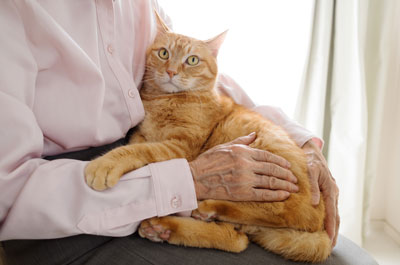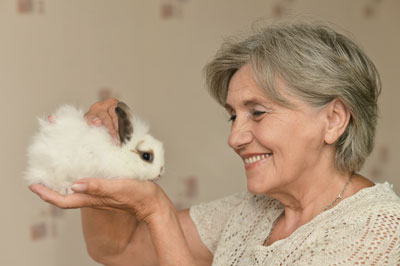Pets in aged care homes makes paw-fect sense with new tool
By Candy Gibson
Australia has launched a new tool to assess whether individual pets can safely be accommodated in aged care homes, easing the stress for many older people moving into residential care.
A team of academics, veterinarians, health and consumer representatives has devised a process to assess different risks for both people and pets, focusing on dogs, cats, small mammals, birds and fish.
Project leader, UniSA pet researcher Dr Janette Young, says the tool assesses a wide range of risks, including allergies, bites/scratches, falls, transmission of diseases and animal stress.

“We want to support older people to keep their pets at an extremely stressful life stage and also reduce the number of pets who become homeless or need to be euthanised when their owner is no longer able to live independently,” Dr Young says.
“But we need to do this in a responsible way, ensuring the safety and health of both animals and people is paramount.”
A 2018 Animal Welfare League report found that only 18 per cent of residential aged care facilities in Australia allowed residents to live with a pet, despite 64 per cent of Australian households owning a pet.
Almost one in two people over the age of 65 have pets but many relinquish them as they age because of fears about who will look after their pets in the event of illness or death, or when they enter a residential care home.
The Companion Animal Multi-Species Risk Management Tool (CAMSRMT) documents three main risks: from humans to animals and vice versa, and risks from animals to animals.

Levels of risks for individual species are rated high to low, assuming pets will be kept in their owners’ rooms, or on a leash when outside or in a communal setting.
“Good hygiene is essential, and most risks can be managed in an aged care home if scrupulous cleaning practices are followed,” Dr Young says.
“However, there are other considerations, including the likelihood of an animal causing a fall or biting/scratching a resident, and human allergies to different species.
“Some people fear animals in general or just don’t like them. Others have a history of mistreating animals. We have to consider a whole range of risks in an aged care home.”
Veterinarian advice includes assessing the risks of residents inappropriately or over feeding pets, animals gaining access to residents’ medication and even the possibility of animals being injured by other pets on the premises.
Although considered low risk, there is also the possibility of disease and infections spreading from humans to pets (rabies, anthrax) and vice versa.
The tool proposes steps to address all these risks, including the following:
- Individual care plans for pets, noting staff and resident animal allergies or fears, and pet alert signs;
- Veterinarian checks pre-admission for health and behaviour;
- Assessing how pets should be kept or moved around the premises;
- Maintenance of an infection control program and a pet care plan;
- Processes for managing pet medication;
- Regular cleaning of litter and cages;
- Microchipping or identification tags.
“Dogs and cats will have different risks compared to rabbits, birds and fish so we have developed scenarios for each species,” Dr Young says.
“The tool is not about guaranteeing that people can bring their loved pets into aged care; this may not be the best option in the end for people or their pets. However, it enables people to work through this as a realistic option and gives advice and tips on how to make this more likely.”
Although developed in Australia, the project was funded by the Society for Companion Animal Studies in the UK and is intended to be used worldwide.
More information about the tool can be found on the Society for Companion Animal Studies website.
Other Stories
- Citizen scientists needed to help tackle mosquito boom
- A healthier heart can protect your brain too. Five lifestyle changes to prevent dementia
- UniSA prepares for perfect landing with second simulator
- More than 30,000 students prepare to hit the books in 2022
- From the Vice Chancellor
- Achievements and Announcements
- First language footy program set to make a mark in APY Lands
- Spotlight on the unseen: MOD. launches new exhibition
- Pets in aged care homes makes paw-fect sense with new tool
- Putting the focus on first-in-family experiences
- Four prominent researchers named inaugural Bradley Distinguished Professors
- The latest books from UniSA researchers
- In Pictures: City West campus over summer



